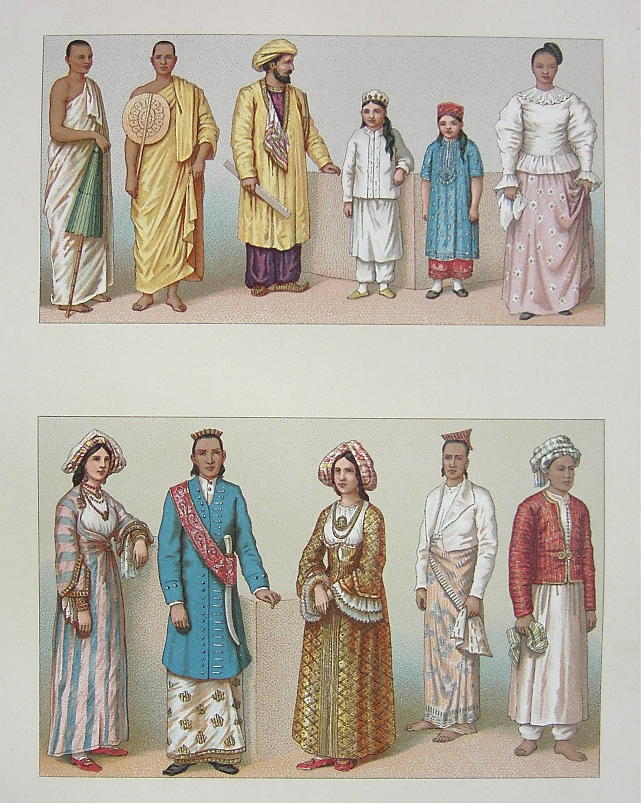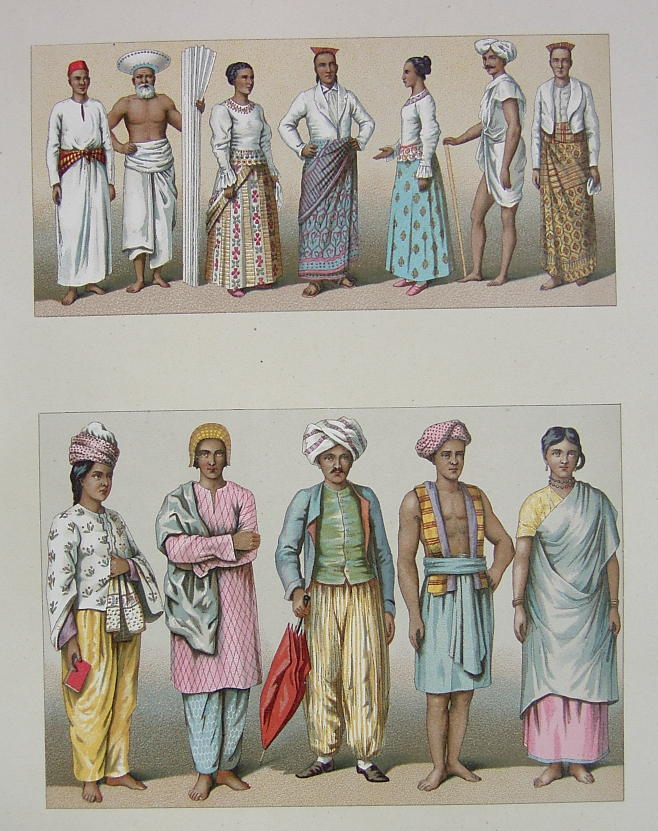

Racinet 1876, on Ceylon
Source: ebay, Nov. 2005
"THE ISLAND OF CEYLON, OR SRI LANKA, is situated at the southern extreme of the Indian peninsula at the entrance to the Bay of Bengal. The native population is divided into four races: thr '.Veddahs, or Beddas, who live in the mountains; the Singhalese, ancient invaders from India who are known as Kandiens in the centre of the island and Singhalese on the coast; the Malabres who also came from India after the Singhalese; and, finally, the Moors. Like the Hindus, the Singhalese still have a caste system, despite the fact that the English tried to abolish it.
Legend: 1 A religious novice 2 A Kandien priest, wearing a yellow robe - yellow being a sacred colour. This is simply a length of material wrapped around the body, leaving the right shoulder and arm bare. For religious reasons, such robes must be made and dyed in the space of a day. 3,7 and 9 A Jew, whose costume is remarkable for its good taste and quality of material. All his clothes, including his turban and even his Indian slippers with gold brocade and turned-up toes, are made of silk. 4 & 5 These two children are probably Parsees. The former is dressed in cotton and the latter in beautiful silk with gold brocade. 6 A Singhalese woman of the middle caste, from the coastal area. Her canezou is made of cotton embroidered at the neck and with a lace collar. 8 A Chief of a village. The noble Singhalese wearing a jacket buttoned up the neck. His comboye is made of silk (notice the sign of Serpent); the shoulder-belt is in silk, embroidered with gold. 10 A Singhalese of the same social rank, his costume in cotton similar to no. 6. 11 A marine officer of Ceylon. His turban is of striped cotton, the stapled jacket is in striped silk and embroidered in gold, the dress and the trousers are made of cotton canvas as well as his handkerchief.."

Costumes of Ceylon (1876)
Source: ebay, Nov. 2005
"Legend: 1.1 A sailor from the Maldives, wearing an Arabian bonnet, cotton clothes and a belt of printed material. 1.2 Kandien nobles. Despite the attempted abolition of the caste system by the English, costume often reflects the old caste traditions. The comboye, worn by both men and women, is the most important article of national costume. It consists of a piece of material wrapped around the hips and fastened with a belt, whose size is an indication of status. The beret is also a mark of nobility and is forbidden to ordinary people, as are gold and silver jewelry. 1.3, 4, 5, & 7 Middle class Singhalese, with costumes appropriate for the hot climate and their sedentary habits. The men wear cotton clothes: colored comboyes that reach to the ankles and small open jackets, Their heads are always covered and their hair is worn in a bun. Women's costume is the same as the men's except that they substitute a canezou for the jacket. 1.6 and 2.1, 2, 3, 4 & 5 Hindus. Their skin is often very shiny because it is customary to cover their bodies with oil many times a day to combat perspiration. Men nearly always have shaved heads, except that in some castes a tuft is left at the back of the head. Women tie their hair back, unless they are widows in mourning or are being punished for some offense, in which case their heads are shaved. They wear saris, which are draped around the body and pulled over the head at the approach of a man, even when they are indoors."